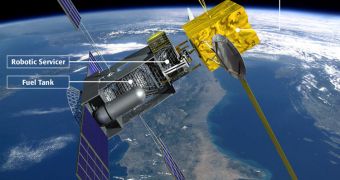One of the main reasons why components of different satellite constellations need to be replaced from time to time is the fact that they simply fail due to wear. Exhausting their fuel supplies is also a common reason, so now experts want to address both issues with a new generation of spacecraft.
They say that building refuel and repair spacecraft capable of servicing other satellites would diminish the long-term costs associated with exploiting space significantly. These vehicles would be able to resupply other satellites with the needed fuel, while performing minor repair work via robotic arms.
MacDonald, Dettwiler and Associates Ltd. (MDA), a Canadian company, is currently working hard on finishing such a design. Their spacecraft is primarily focused on acting as a mobile refueling station.
At the same time, US Space and Alliant Techsystems (ATK) – an aerospace firm and a rocket manufacturer, respectively – are working towards developing robotic equipment that, once installed on a repair satellite, would be able to carry out minor repairs on spacecraft already in orbit.
It would be rather interesting to see whether these two designs could be centralized in a single project, analysts say. That would certainly help change the way in which satellite constellations are now being taken care of.
The Upper Atmosphere Research Satellite (UARS) that crashed to Earth last month was a good example of what happens when an orbital sentry consumes all of its fuel, leaving none to be burned during a controlled atmospheric reentry.
“The space infrastructure is an incredibly fragile thing. We totally rely on that network, but strangely we don't service it, unlike any other network that we use. Road networks, sewer networks – all of those networks we service,” said Steve Oldham, as quoted by Space.
The expert – who holds an appointment as the president of Space Infrastructure Services at MDA – was speaking to experts gathered at the 2011 Satellite and Content Delivery Conference & Expo., on Wednesday, October 11.
“I think the issue of why we want to do [this] is pretty obvious. We want to be able to touch our assets, and we want to be able to see them,”Intelsat vice president of legal and government affairs, Richard DalBello, explained.
“A large number of satellites are de-orbited that are perfectly good, perfectly functioning satellites. The ability to refuel is a very powerful technology,” the official told attendants at the conference.
One of the things that analysts discovered over time was that most satellites being retired from active service still retain most of their subsystems in working order. They have no more fuel to go on, or maybe one of their precious antennas is broken. The new spacecraft might address these issues soon.

 14 DAY TRIAL //
14 DAY TRIAL //